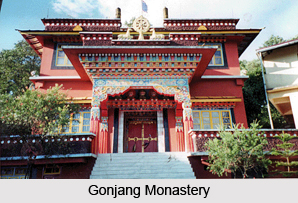 Gonjang Monastery near Tashi View Point in Sikkim was established in the year 1981. It was founded by H.E. Tingkye Gonjang Rimpoche. He was recognized as an incarnation of Yolmo Terton Ngakchang Shakya Zangpo, a 15th century Nyingmapa Terton. The monastery follows Jangter tradition of Nyingmapa school of Tibetan Buddhism.
Gonjang Monastery near Tashi View Point in Sikkim was established in the year 1981. It was founded by H.E. Tingkye Gonjang Rimpoche. He was recognized as an incarnation of Yolmo Terton Ngakchang Shakya Zangpo, a 15th century Nyingmapa Terton. The monastery follows Jangter tradition of Nyingmapa school of Tibetan Buddhism.
History of Gonjang Monastery
Terton Shakya Zangpo`s sixth reincarnation Rigzin Pema Choephel (1773-1836) studied from Rigzin Kunzang Dorje who was the spiritual son of previous Rinpoche. He was a great scholar and a poet who had written many valuable texts. He also took renovations to the fabric of the Great Stupa as his predecessors.
According to history once Rigzin Kunzang Dorje was under rigorous meditation practice in a cave situated in the north of Zar and Phukut village in Tsang Tingkye. There he attained the stage of highest realization or complete accomplishment through his firm contemplation. Tulku Rigzin Thutop Dorje, the fifth Yolmo visited the cave and bestowed his teaching and blessings on his heart son Rigzin Kunzang Dorje along with many disciples. He also blessed this cave as a sacred place or an ideal place for the establishment of Dharma center. In advance, he gave the name of Gonpa as "Gonjang Samten Choephug:"
Hence the Gonjang Monastery came into being and thereafter successive Yolmo Tulkus were named as Gonjang Tulkus. Rigzin Pema Choephel dedicated his whole life by imparting knowledge to others. He emphasized upon spiritual and academic development. Therefore the construction of images and gonpas, collection of rare and invaluable scriptures, academic studies were his first priority.
During his tenure, he collected voluminous religious texts both sutras and Mantra such as two sets of "Kagyur and Tengyur" and two sets of "Nyingma Gyud Bhum."
Xth Yolmopa the present Tingkey Gonjang Rinpoche is trained traditionally under several renowned Nyingmapa masters. The foundation stone of Gonjang Monastery at Gangtok was laid by H.H. the XIVth Dalai Lama in the year 1981. It was started from the small group of monk students in the Sheda. It has emerged as one of the prime center of Buddhist learning in Sikkim. The main objective of this organization is for the preservation and development of our rich culture in this part of the world.
Being rather backward and destitute the establishment of this organization is inevitable so as to promote and educate the younger generation both physically and mentally.
Here the Monk students are taught all kinds of monastic education along with Tibetan language and English. Comparative studies of Indian and Tibetan Buddhist philosophy based on moral values are taught.
Festivals of Gonjang Monastery
On the auspicious occasion of Buddha Purnima, a festival is celebrated that is popularly known as `Saga Dawa.` The festival is celebrated in the fourth month of the lunar calendar with much festivity, offerings and prayers. During this festival Gonjang Rinpoche blesses the day by imparting religious discourse and gives empowerment to hundreds of devotees attended in the day for his blessing.
Another festival Droogpa Tse-Shi is celebrated during the sixth month of the lunar calendar. It is the auspicious occasion of commemorating the Buddha`s first turning the wheel of the Dharma. The festival is celebrated in a traditional way. Religious discourse and talks are organized for the disciple who took part and witness it.
Similarly, other special occasions like `Pang Lhasol` and `Lhabab Duchen`, are also observed by worshipping the guardian deity of Sikkim and Buddha Shakyamuni respectively.
Finally, entourage of monks to the holy places like Bodh Gaya, Varanasi, Rajgriha are scheduled every December and January, when thousands of devotees from all over the world gather to take part in the Nyingma International Peace Aspiration Prayer. The Gonjang Monastery organizes seminars, talks and religious discourse to promote and preserve the spiritual heritage among the future generations.



















